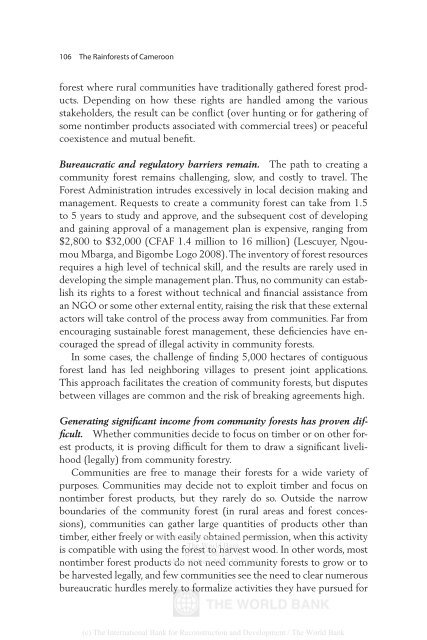The Rainforests of Cameroon - PROFOR
The Rainforests of Cameroon - PROFOR
The Rainforests of Cameroon - PROFOR
- No tags were found...
You also want an ePaper? Increase the reach of your titles
YUMPU automatically turns print PDFs into web optimized ePapers that Google loves.
106 <strong>The</strong> <strong>Rainforests</strong> <strong>of</strong> <strong>Cameroon</strong>forest where rural communities have traditionally gathered forest products.Depending on how these rights are handled among the variousstakeholders, the result can be conflict (over hunting or for gathering <strong>of</strong>some nontimber products associated with commercial trees) or peacefulcoexistence and mutual benefit.Bureaucratic and regulatory barriers remain. <strong>The</strong> path to creating acommunity forest remains challenging, slow, and costly to travel. <strong>The</strong>Forest Administration intrudes excessively in local decision making andmanagement. Requests to create a community forest can take from 1.5to 5 years to study and approve, and the subsequent cost <strong>of</strong> developingand gaining approval <strong>of</strong> a management plan is expensive, ranging from$2,800 to $32,000 (CFAF 1.4 million to 16 million) (Lescuyer, NgoumouMbarga, and Bigombe Logo 2008). <strong>The</strong> inventory <strong>of</strong> forest resourcesrequires a high level <strong>of</strong> technical skill, and the results are rarely used indeveloping the simple management plan. Thus, no community can establishits rights to a forest without technical and financial assistance froman NGO or some other external entity, raising the risk that these externalactors will take control <strong>of</strong> the process away from communities. Far fromencouraging sustainable forest management, these deficiencies have encouragedthe spread <strong>of</strong> illegal activity in community forests.In some cases, the challenge <strong>of</strong> finding 5,000 hectares <strong>of</strong> contiguousforest land has led neighboring villages to present joint applications.This approach facilitates the creation <strong>of</strong> community forests, but disputesbetween villages are common and the risk <strong>of</strong> breaking agreements high.Generating significant income from community forests has proven difficult.Whether communities decide to focus on timber or on other forestproducts, it is proving difficult for them to draw a significant livelihood(legally) from community forestry.Communities are free to manage their forests for a wide variety <strong>of</strong>purposes. Communities may decide not to exploit timber and focus onnontimber forest products, but they rarely do so. Outside the narrowboundaries <strong>of</strong> the community forest (in rural areas and forest concessions),communities can gather large quantities <strong>of</strong> products other thantimber, either freely or Delivered with easily by <strong>The</strong> World obtained Bank permission, e-library to: when this activity<strong>The</strong> World Bankis compatible with using the forest IP : 192.86.100.34 to harvest wood. In other words, mostnontimber forest products Mon, do 09 not Nov need 2009 community 17:06:18 forests to grow or tobe harvested legally, and few communities see the need to clear numerousbureaucratic hurdles merely to formalize activities they have pursued for(c) <strong>The</strong> International Bank for Reconstruction and Development / <strong>The</strong> World Bank
















